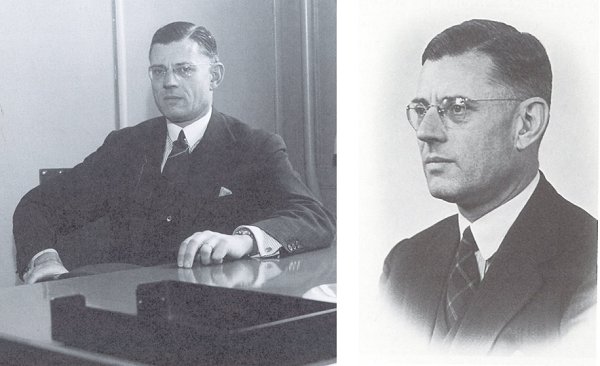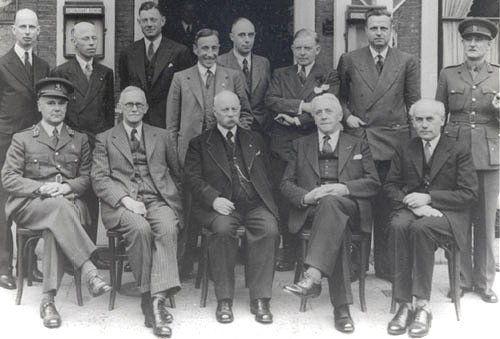

Theodoor Philibert Tromp was born the 9th of June 1903 in Voorburg Holland. He came from a well to do liberal protestant (Nederlands Hervormd) family, with his father Herman Adrianus Tromp being an attorney. In 1926 he receives his Master degree in Mechanical Enigineering at the Technical University of Delft. After working for a year as a consulting engineer for the firm Louwers & Co, he joins Philips in 1927.
From the beginning Tromp combined an enormous ambition with a colossal energy. Ir. Pannenborg who worked very close with him for many years, describes him as an enormous worker, an engine. He prefers to compare him with “von Wallenstein” who was the General of the Holy Roman Emperor Ferdinand II during the Thirties Year War from 1618-1648! Wallenstein although not being a brilliant general was a tremendous organizer. Tromp himself claimed he was a descendant from the Dutch sea hero Maarten Tromp. He was indeed a sailor himself, and he like to boast to his colleagues about his sailing adventures. A favorite story of him described how on one of his boat trips on the English Channel he was forced to take shelter from the storm in a harbor on the South Coast of England. When the harbor master asked his name, he replied “Tromp of Holland” upon which the harbor master signaled back “What? again.” Tromp certainly didn’t suffer from a lack of self confidence.
A year after joining Philips, still at the very young age of 25, Tromp was assigned to integrate, under very difficult circumstances, a newly acquired tool factory in Berlin into the Philips organization. There he not only learned the German language fluently, but he also performed his task so well that on his return in 1931 he was appointed as head of the “Radio Valve Foreign Department.” Early 1939 he became General Head of the “Radio Valve Department.” (development and manufacturing) as well as supervisor of the “Radio Valve Factories Abroad” a position he kept until the end of the war.
At the beginning of the war, Tromp was asked to come to London on the request of the British Government. At that occasion Watson-Watt persuaded Tromp to produce and deliver as much as possible EF50 RF pentodes, which formed a vital part of the British radar systems. Starting from 1942 Tromp became more and more involved in the Dutch Resistance and espionage for the Allied. He financed the resistance, helped other colleagues involved in espionage leaving the country, and was involved in the building and setting up of a backup radio transmitter network which should come into action in case the Germans would destroy the Dutch broadcast transmitters in an invasion of the Allied Forces. He gathered crucial information regarding the production for the Germans of Philips and other companies in occupied Holland. The group of industrials who were involved in this activity operated under the code name “Harry.” The information was communicated to the intelligence agencies in London mainly through carriers who could travel “for bussines” to Switserland. Besides this the production for the German occupier was heavily sabotaged.
After the south of Holland had been liberated he became Minister of “Verkeer en Waterstaat” (Public Transport, Infrastructure etc.) from 5th April 1945 to 23rd June 1945 in the third Cabinet of Prime Minister Gerbrandy. After he returned to Philips he became a member of the Board of Directors 1946 to 1957, Responsible for all production and technology except Research. From 1957 to 1967 he held the position of Vice President of Philips. He retired a year later. Besides his functions with Philips, Tromp was a member of a number of boards of commissioners for amongst others: The Steaming Company “Zeeland,” The Dutch Railways and the Royal Dutch Airlines.
Theo Tromp married Gerdina Gerritsz in Haarlem on the 10th of May 1929. They had two sons and two daughters. His wife died the 9th of November 1968. He remarried the 28th of May 1970 to Maria Doorman. Tromp died the 1st of June 1984 in Eindhoven on the age of 81.
Tromp was a Knight in the Order of Oranje-Nassau (1946), and Commander in the same order (1967).

The Post-war “cabinet Gerbrandy III”
Back row, left to right: Van Kleffens, Van Beel, Tromp, De Quay, Huysmans, De Booy, Gispen + ?
Front row, left to right: gen Kruls, Schmutzer, Gerbrandy, Bolkenstein, Wijffels.